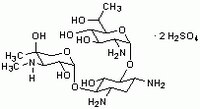509290 MilliporeOmniPur® G418 Sulfate, Cell Culture Tested - CAS 108321-42-2 - Calbiochem
G418 is an aminoglycoside antibiotic related to gentamycin that inhibits prokaryotic and eukaryotic protein synthesis.
More>> G418 is an aminoglycoside antibiotic related to gentamycin that inhibits prokaryotic and eukaryotic protein synthesis. Less<<Synonyms: NMD Inhibitor I
Recommended Products
Overview
| Replacement Information |
|---|
Key Specifications Table
| CAS # | Empirical Formula |
|---|---|
| 108321-42-2 | C₂₀H₄₀N₄O₁₀ · 2H₂SO₄ |
| Product Information | |
|---|---|
| CAS number | 108321-42-2 |
| Form | White powder |
| Hill Formula | C₂₀H₄₀N₄O₁₀ · 2H₂SO₄ |
| Chemical formula | C₂₀H₄₀N₄O₁₀ · 2H₂SO₄ |
| Quality Level | MQ200 |
| Applications |
|---|
| Biological Information | |
|---|---|
| Biological activity | Assay: ≥730 µg/mg |
| Purity | ≥90% by HPLC |
| Physicochemical Information | |
|---|---|
| Contaminants | Heavy metals: ≤100 ppm UV Absorbance (280 nm, 100 mg/ml in H₂O) ≤ 0.35 |
| Dimensions |
|---|
| Materials Information |
|---|
| Toxicological Information |
|---|
| Safety Information according to GHS | |
|---|---|
| RTECS | CB9378500 |
| Safety Information |
|---|
| Product Usage Statements |
|---|
| Packaging Information |
|---|
| Transport Information |
|---|
| Supplemental Information |
|---|
| Specifications |
|---|
| Global Trade Item Number | |
|---|---|
| Catalog Number | GTIN |
| 509290 | 0 |
Documentation
OmniPur® G418 Sulfate, Cell Culture Tested - CAS 108321-42-2 - Calbiochem SDS
| Title |
|---|
OmniPur® G418 Sulfate, Cell Culture Tested - CAS 108321-42-2 - Calbiochem Certificates of Analysis
| Title | Lot Number |
|---|---|
| 509290 |
References
| Reference overview |
|---|
| Ethier, S.P., and Taback, E. 1993. Cancer Lett. 74, 189. Santerre, R.F., et al. 1991. Methods Mol. Biol. 7, 245. Maniatis, T., et al. 1989. In Molecular Cloning, A Laboratory Manual, Second Edition, Cold Spring Harbor, NY. Edwards, S.A., and Adamson, E.D. 1987. J. Cell Physiol. 133, 46. Ernst, J.F., and Chan, R.K. 1985. J. Bacteriol. 163, 8. Canaani, D., and Berg, P. 1982. Proc. Natl. Acad. Sci. USA 79, 5166. Hirth, K.P., et al. 1982. Proc. Natl. Acad. Sci. USA 79, 7356. Ursic, D., et al. 1981. Biochem. Biophys. Res. Commun. 101, 1031. Jimenez, A., and Davies, J. 1980. Nature 287, 869. |














